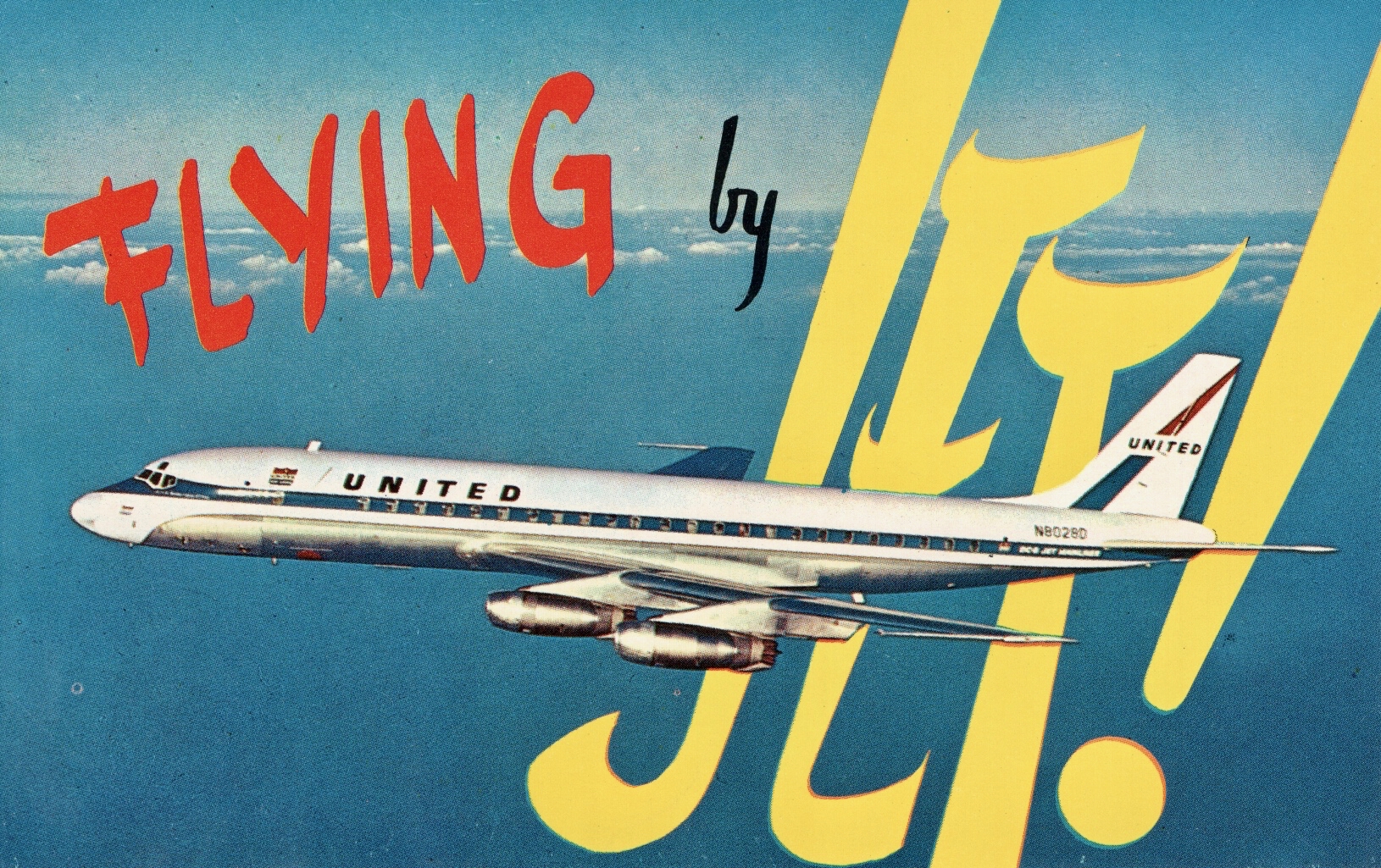
First Generation Pure Jet Commercial Aircraft on Postcards
Written by Marvin G. Goldman
This article covers the earliest pure jet (turbojet) aircraft operated by airlines — the de Havilland Comet, Tupolev Tu-104, Boeing 707, Douglas DC-8, Sud Aviation SE-210 Caravelle, and Convair 880 — all as portrayed on postcards.
The de Havilland Comet 1 was the world’s first pure jet aircraft to enter scheduled airline service. It first flew on 27 July 1949 and made its first scheduled airline flight with British Overseas Airways Corporation (B.O.A.C.), on the London to Johannesburg route, on 2 May 1952. The aircraft represented a revolution in airline travel, in terms of speed, comfort and lower maintenance costs.
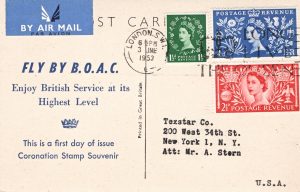
Back of preceding postcard. B.O.A.C. issued this card on 3 June 1953, with postage stamps commemorating the coronation the day before of Queen Elizabeth II of England. The postmark says ‘Long Live the Queen’. Indeed the Queen is still living, well over 60 years later.
Jubilation at the introduction of the Comet jetliner, however, soon turned to tragic disappointment, as a series of disastrous fatal crashes of the Comet 1 from October 1952 through April 1954 led to the permanent grounding of the type. Extensive salvage and testing determined that metal fatigue leading to structural failure was the main cause of most of the accidents.
Major changes to the Comet design were made, leading to the ‘Comet 4’, which featured rounded (rather than square) windows and numerous improvements. The Comet 4 entered commercial jet service when B.O.A.C. operated the first trans-Atlantic jet flight, London to New York, on 4 October 1958. The Comet 4 type was also exported to several other airlines outside the U.K., of which Aerolineas Argentinas was the first purchaser.
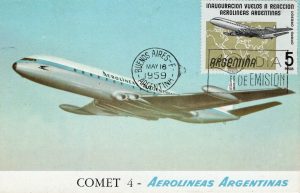
Aerolineas Argentinas de Havilland Comet 4. Airline Issue, 1959. Two versions of this card exist, one with the back imprint in Spanish and one in English. With the Comet 4, Aerolineas Argentinas set three world records — first jet airliner service in South America (16 April 1959, Buenos Aires to Santiago, Chile); first jet service across the south Atlantic to Europe (19 May 1959); and first jet connection between North and South America (7 June 1959, Buenos Aires-New York.)
Amidst the development of the successful first generation jetliners covered in this article, there is one pioneer type worth mentioning even though only one flying example was produced. Starting in 1945 Avro Canada, with some initial collaboration by Trans-Canada Airlines (TCA), worked on developing a medium-range regional pure jet. This resulted in the Avro C102 Jetliner, which first flew in 1949 just a few days after the first flight of the Comet 1. In April 1950 the sole Avro prototype flew the world’s first jet airmail, from Toronto to New York, in 58 minutes, and the crew received a ticker tape parade in Manhattan. Nevertheless, by then TCA had withdrawn from the project, and other sales prospects did not materialize.
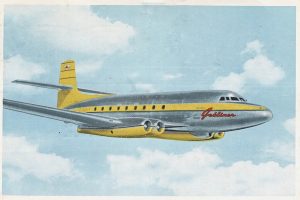
Avro Canada C102 Jetliner, postcard issued by the manufacturer and carried on the world’s first airmail jet service, from Toronto to New York, April 1950.
Meanwhile, at the beginning of the 1950s the Soviet Union started development of its own first pure jet commercial aircraft. This resulted in the Tupolev Tu-104 two-engine medium-range turbojet. The Tu-104, operated by Aeroflot, was the second jetliner (after the Comet 1) to enter scheduled passenger service, from Moscow to Irkutsk in Siberia, on 15 September 1956. Moreover, as noted aviation historian Ron Davies has pointed out, the Tu-104 provided the first ‘sustained’ commercial jet airliner service, because the Comet was grounded starting in 1954 due to accidents and only resumed passenger service in October 1958 in the form of the new Comet 4.
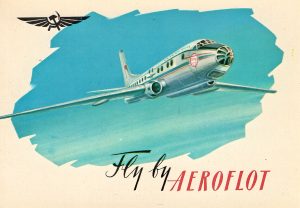
Aeroflot Tupolev Tu-104A, Airline Issue, probably late 1950s. Artist card designed to show the speed and drama of this pioneering jet aircraft.
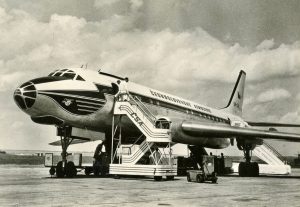
CSA Czechoslovak Airlines Tupolev Tu-104A, OK-LDA, probably late 1950s. Pub’r Orbis. Paul Roza collection. Note the unusual two-story stairway at the front door. CSA was the only export customer for the Tu-104 and utilized them on routes from Prague to Brussels, Paris and Moscow.
After the British Comet aircraft demonstrated in 1952 that the age of commercial pure jet aircraft was closer than originally imagined, U.S. aircraft manufacturers started work in earnest on their own passenger pure jet aircraft. Boeing started developing the 707 based on the prototype Boeing 367-80 that originally was designed as a tanker for large U.S. Air Force bombers and had first flown on 15 July 1954. The resultant 707-100 series made its first flight on 20 December 1957, and the production effort was so intense that the first example was delivered to Pan American less than eight months later — on 15 August 1958. Airline historian Ron Davies states, “The Boeing 707 clearly ranks as one of the half dozen most significant airliners of all time.”
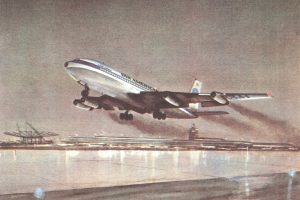
Pan American Boeing 707-100 taking off from New York Idlewild (now JFK) International Airport on the evening of 26 October 1958, on the world’s first 707 commercial flight, trans-Atlantic New York to Paris. Airline issue as part of a historical series of artist paintings on postcards by John T. McCloy. On the left side of this postcard you can see the Pan Am Worldport terminal under construction. Pan Am was the second airline to start trans-Atlantic jet service, just 22 days after B.O.A.C. did so with the Comet 4.
Other airlines raced to join the new jet age revolution. TWA’s controlling shareowner, Howard Hughes, ordered 707s in February 1956. New York aviation photographer and publisher George Enell even issued the following postcard in 1957 with an artist’s concept of what a TWA 707 might look like.
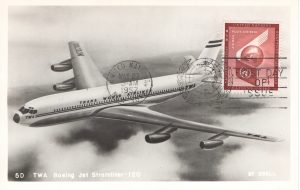
Artist’s concept of what a Trans World Airlines (TWA) Boeing 707 might look like. Postmarked 27 May 1957. Pub’r Enell, no. 5D.
For domestic U.S. pure jet passenger service, the major U.S. airlines tried to outdo one another in being the first to provide it — either with Boeing 707s or with Douglas DC-8s which were being developed simultaneously. This included American, Delta, Eastern, National and TWA. While American and TWA were in line for 707s, Delta, Eastern and National awaited DC-8s which unfortunately were delayed in production.
National, upstaging the other airlines and gaining valuable publicity, leased a 707 from Pan American, and on 10 December 1958 it provided the first domestic U.S. commercial jet service, New York – Miami.
The first domestic U.S. jet service with an aircraft owned by the airline was provided by American Airlines on 25 January 1959. It was transcontinental, New York-Los Angeles, and it was dramatic.
TWA quickly followed, introducing the Boeing 707 on the New York-San Francisco transcontinental route on 20 March 1959. It also was the second airline, after Pan Am, to utilize the 707 on trans-Atlantic service, starting 21 November 1959.
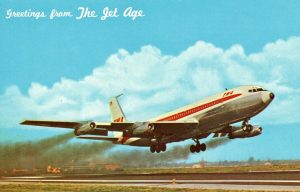
TWA Boeing 707-100 takeoff. Pub’r H. S. Crocker Co., San Francisco. You can feel the roar of the engines and see the trail of dark smoke on takeoff, caused by water injection to provide sufficient thrust, that characterized the earliest 707s.
A third early entrant on U.S. domestic 707 service was Continental Airlines. With 707s it initiated Chicago-Los Angeles nonstop service on 8 June 1959. My own first airline flight was on a Continental 707, Los Angeles-Denver-Chicago, 17 December 1959. Here is the postcard obtained from the seat pocket on that flight.
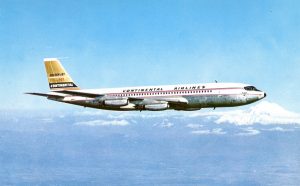
Continental Airlines Boeing 707-100 ‘Golden Jet’, with Mt. Rainier, Washington, in the background, on Boeing pre-delivery flight. Airline Issue, 1959.
The first non-U.S. airline to operate the 707 was Australia’s QANTAS, on 29 July 1959, on the Sydney-Nadi-Honolulu-San Francisco route. This was also the first pure jet service across the Pacific Ocean.
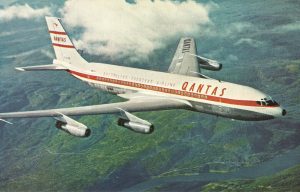
QANTAS Boeing 707-138. Airline Issue, 1959. The earliest 707s of QANTAS were a shorter-bodied type specifically built for it. The first one of that type, originally VH-EBA, was restored to airworthiness in 2006 and is now based at the Qantas Founders Outback Museum in Longreach, Australia.
During the first three months of 1960, three European airlines — SABENA, Air France and Lufthansa — introduced Boeing 707s on their trans-Atlantic routes, and Air India became the first Asian airline to operate 707s. Here are postcard examples of these airlines.
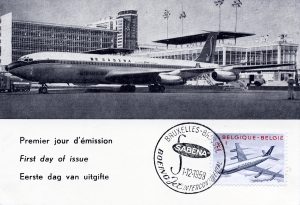
SABENA Boeing 707-400. Airline Issue, postmarked 1 December 1959, the first day of issue of a Belgian postage stamp honoring a SABENA 707. SABENA was the first European airline to introduce 707 trans-Atlantic service, on 23 January 1960.
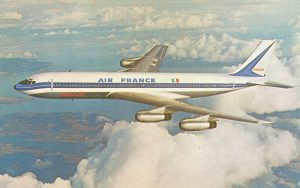
Air France Boeing 707-400. Airline Issue no. S25980. Ex Deke Billings collection. Air France introduced 707 trans-Atlantic service on 2 February 1960.
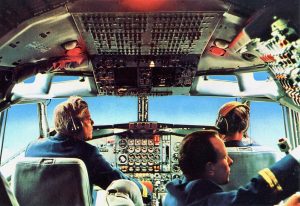
Lufthansa Boeing 707-400 Flight Deck. Airline Issue. Lufthansa introduced trans-Atlantic 707 service on 17 March 1960.
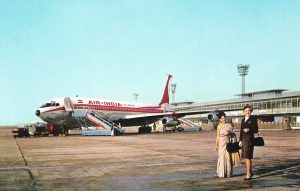
Air India 707-400 VT-DMN ‘Kanchenjunga’ at Paris-Orly. Editions P.I., Paris, no. 158. The publisher also reprinted this postcard as no. 200. Air India became the first Asian airline to operate pure jet aircraft. On 14 May 1960 it inaugurated 707 intercontinental service, Bombay-New York with intermediate stops in Beirut and London.
At the same time that Boeing was developing the 707, Douglas Aircraft was working on its first jetliner, which became known as the ‘DC-8’. Unfortunately for Douglas, the 707 entered airline service first, garnering orders from many airlines that wanted to be among the first to offer pure jet service. Several airlines, however, preferred to stick with Douglas aircraft and awaited their first deliveries of DC-8s, which occurred in 1959 and 1960. These included six airlines — Delta, United, Eastern, National, Trans-Canada (TCA) and KLM — who were among the first seven operators of DC-8s (the seventh being Pan Am that also utilized 707s). Here are DC-8 postcards of those six airlines.
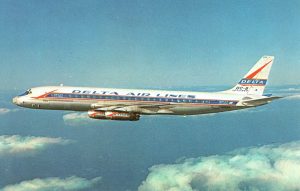
Delta Air Lines Douglas DC-8-11, N802. Airline Issue, nos. T-312 and 0DK-174. Delta operated the world’s first scheduled DC-8 jet service, New York-Atlanta, on 18 September 1959.
Just two hours and 10 minutes after Delta’s initial DC-8 flight, also on 18 September 1959, United Airlines launched its own first DC-8 service, transcontinental San Francisco-New York. The following postcard highlights the excitement of flying by ‘JET!’
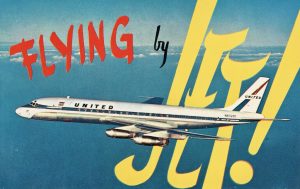
United Airlines Douglas DC-8-11. Pub’r Colourpicture, Boston MA, no. P31751; Dist’r Mitock & Sons, Sherman Oaks CA.
Eastern, National, Trans-Canada and KLM followed successively in 1960 with their initial DC-8 service.
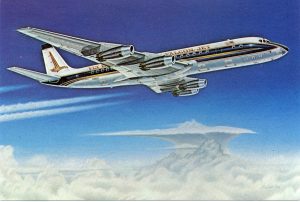
Eastern Air Lines Douglas DC-8-21. Mike Machat artist, 1978. Pub’r Aviation World, Bethel CT nos. AACS-1 and 63188-D. Eastern commenced DC-8 service on 20 January 1960 on its main route New York-Miami.
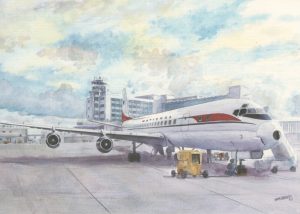
National Airlines DC-8 at Miami. Eric Speyer artist. Issued by Miami International Airport as part of a series of postcards commemorating the history of the airport. Oversize card (5 x 7”; 12.6 x 17.7 cm.)
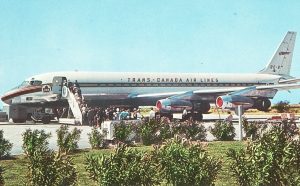
Trans-Canada Air Lines (TCA) Douglas DC-8 at Seawell, Barbados. Pub’r Dexter Press, West Nyack NY no. 63766-B; photo by H. Frisch. Ex Tadd Kotick collection. TCA started DC-8 service on 1 April 1960 on route Montreal-Toronto-Vancouver.
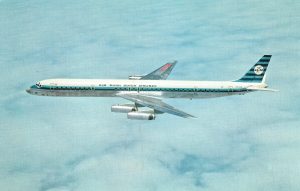
KLM Royal Dutch Airlines Douglas DC-8-63. Airline Issue. KLM launched DC-8 service on 16 April 1960 on the Amsterdam-New York route. This postcard shows the later and larger DC-8-63 model, which was first flown by KLM.
While the British aviation industry and Boeing and Douglas in the U.S. initially focused on four-engine medium to long-range pure jet aircraft, the French aviation industry started in the early 1950s to develop a short to medium-range regional two-engine pure jet aircraft. This resulted in the new rear twin-engine design of what became the Sud Aviation SE-210 Caravelle.
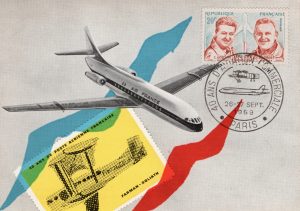
Air France Sud Aviation SE-210 Caravelle. Airline Issue, 26-27 September 1959, with postmark commemorating 40 years of commercial aviation in France. Air France was the first Caravelle operator. It started an experimental Caravelle freight service as early as 21 June 1956, and initiated scheduled passenger Caravelle service on 6 May 1959, Paris-Rome-Istanbul.
The Caravelle proved to be very popular, and soon several airlines outside France were purchasing the aircraft for their shorter routes.
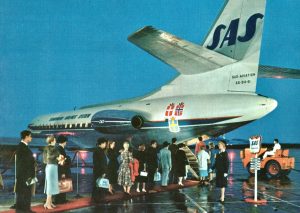
Scandinavian Airlines System – SAS Sud Aviation SE-210 Caravelle boarding passengers. Airline Issue. SAS was the second airline to place the Caravelle in revenue service, on 15 May 1959 — just nine days after Air France. It was also the second largest operator of the type after Air France.
The popularity of the Caravelle was such that United Air Lines surprised the U.S. aviation industry by ordering 20 Caravelle jets in 1960 and placing them in service starting in 1961.
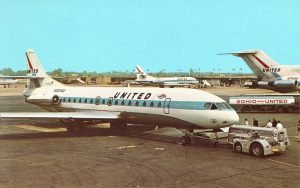
United Air Lines Sud Aviation SE-210 Caravelle, N1014U, at Cleveland Hopkins International Airport. Pub’r Curteich no. 7DK-1671, 1967, Dist’r George E. Klein News, Cleveland. Ex Deke Billings collection. United’s first Caravelle flight was on 14 July 1961, New York-Chicago.
In addition to Boeing and Douglas, one more U.S. aircraft manufacturer pursued development of a pure jet in the 1950s — Convair. This resulted in the Convair 880, an aircraft famed for its speed.
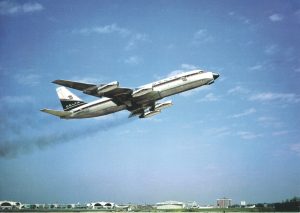
Delta Air Lines Convair 880 taking off from Atlanta. Issued by the Delta Air Lines Heritage Museum, 2002. Delta was the first operator of the Convair 880, placing it on the Houston-New York route on 15 May 1960.
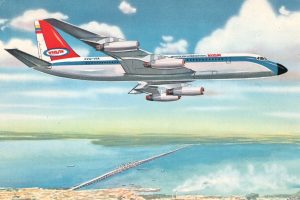
VIASA Convair 880, YV-C-VIA. Airline Issue. Vicente Sanchez artist. VIASA was the first Latin American operator of the Convair 880, introducing it in scheduled service on 8 August 1961. I had the pleasure of flying on a VIASA Convair 880 on 10 September 1967, Aruba to New York JFK.
I hope you enjoyed this postcard look at the first generation of pure jet aircraft, spanning the 1950s through 1961. If you have any comments on any of my articles, you can contact me through the World Airline Historical Society.
Notes: All postcards shown are from the author’s collection, except as noted. I estimate that all of these are uncommon, except this article’s postcards showing Continental, Delta (both), Eastern, KLM, Pan Am and QANTAS aircraft, which are fairly common.
References:
Proctor, Jon; Machat, Mike; and Kodera, Craig. From Props to Jets: Commercial Aviation’s Transition to the Jet Age 1952-1962 (Specialty Press, 2010).
Breffort, Dominique. Boeing 707 (Historie et Collections, Paris, 2008).
Davies, R.E.G. Individual books on the de Havilland Comet, Aeroflot, Delta, Eastern, Pan American and TWA (Paladwr Press, various dates).
Davies, R.E.G., Airlines of the Jet Age (Smithsonian, 2011).
Kennedy, Charles. ‘The Douglas DC-8’, Parts I and II, Airways Magazine (Jan.-Feb. 2016).
Proctor, Jon. Convair 880 & 990. Great Airliners Series Vol. One (World Transport Press 1996).
Waddington, Terry. Douglas DC-8. Great Airliners Series Vol. Two (World Transport Press 1996).
Wegg, John. Caravelle: The Complete Story (Airways International 2005).
Until next time, Happy Collecting,
Marvin
Trackback from your site.

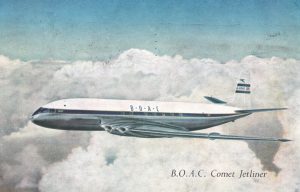
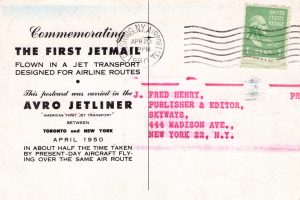
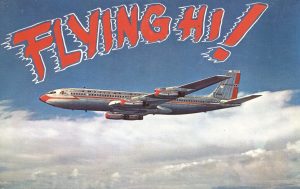
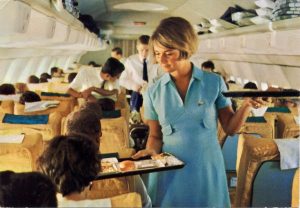
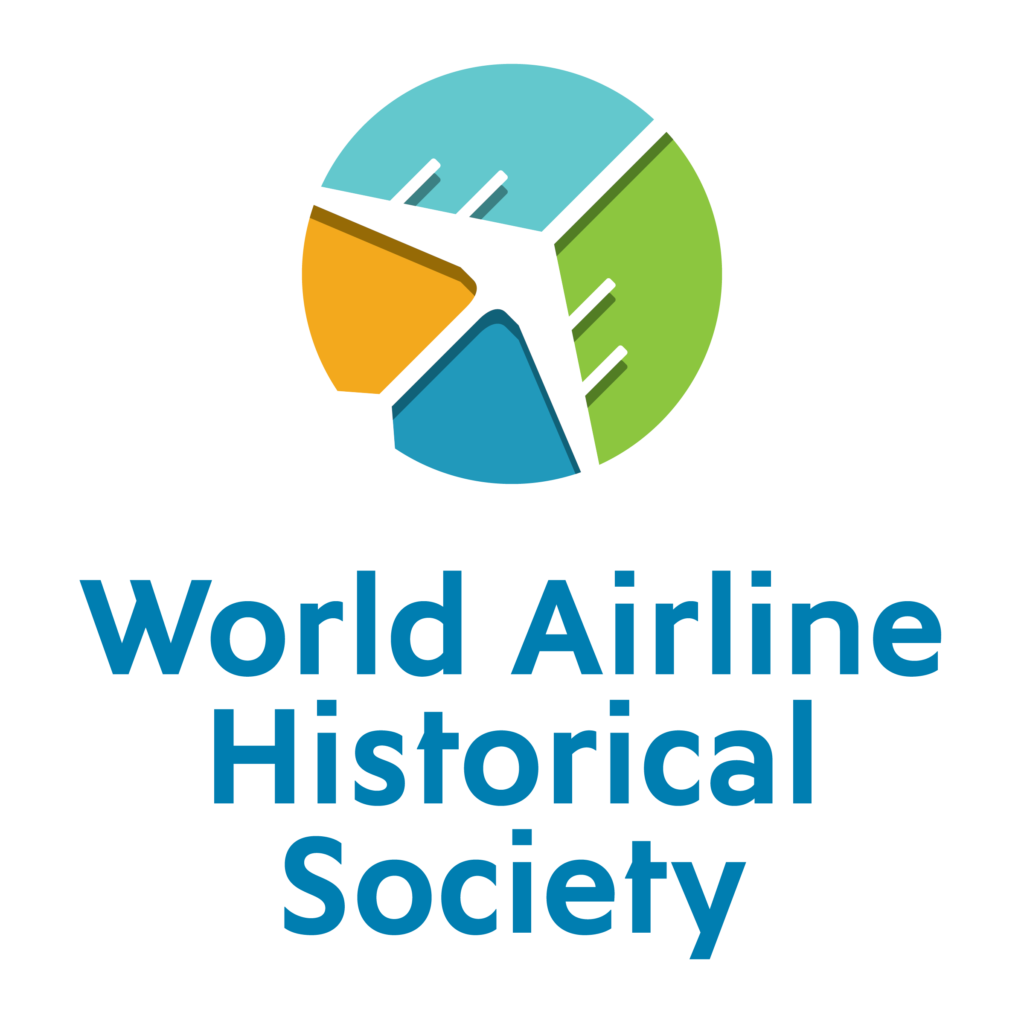
Don Stanton
| #
Wonderful article! i am a retired Navy, Delta pilot and appreciated the flow of your work.
Reply